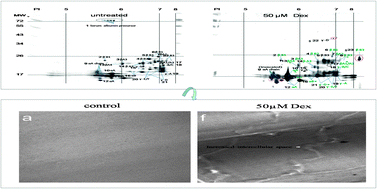Lens proteomics: analysis of rat crystallins when lenses are exposed to dexamethasone†
Abstract
To identify

* Corresponding authors
a
Eye Hospital, The First Affiliated Hospital, Harbin Medical University, 23 Youzheng Road, Harbin 150001, China
E-mail:
ping_liu53@hotmail.com
Fax: 0086-0451-53650320
Tel: 0086-0451-53643849-3958
b Key Laboratory of Harbin Medical University Eye Center, China
c The First Affiliated Hospital, Harbin Medical University, Harbin, China
d Harbin Veterinary Research Institute, Chinese Academy of Agricultural Science, Harbin 150001, China
To identify

 Please wait while we load your content...
Something went wrong. Try again?
Please wait while we load your content...
Something went wrong. Try again?
L. Wang, W. C. Zhao, X. L. Yin, J. Y. Ge, Z. G. Bu, H. Y. Ge, Q. F. Meng and P. Liu, Mol. BioSyst., 2012, 8, 888 DOI: 10.1039/C2MB05463A
To request permission to reproduce material from this article, please go to the Copyright Clearance Center request page.
If you are an author contributing to an RSC publication, you do not need to request permission provided correct acknowledgement is given.
If you are the author of this article, you do not need to request permission to reproduce figures and diagrams provided correct acknowledgement is given. If you want to reproduce the whole article in a third-party publication (excluding your thesis/dissertation for which permission is not required) please go to the Copyright Clearance Center request page.
Read more about how to correctly acknowledge RSC content.
 Fetching data from CrossRef.
Fetching data from CrossRef.
This may take some time to load.
Loading related content
